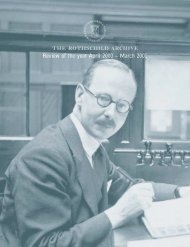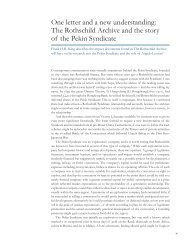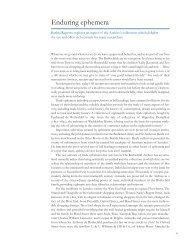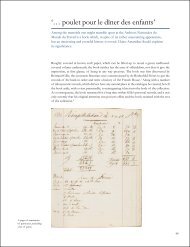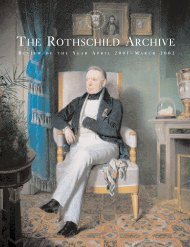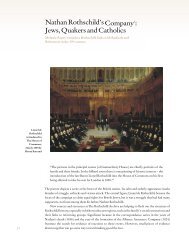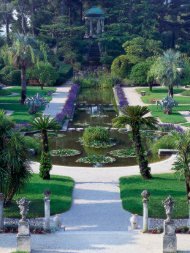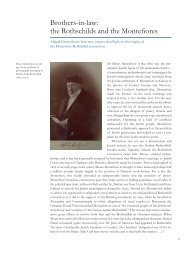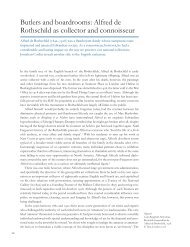Far-Sighted Charity: Adolphe and Julie de Rothschild and their eye
Far-Sighted Charity: Adolphe and Julie de Rothschild and their eye
Far-Sighted Charity: Adolphe and Julie de Rothschild and their eye
You also want an ePaper? Increase the reach of your titles
YUMPU automatically turns print PDFs into web optimized ePapers that Google loves.
<strong>Far</strong>-<strong>Sighted</strong> <strong>Charity</strong>:<br />
<strong>Adolphe</strong> <strong>and</strong> <strong>Julie</strong> <strong>de</strong> <strong>Rothschild</strong> <strong>and</strong><br />
<strong>their</strong> <strong>eye</strong> clinics in Paris <strong>and</strong> Geneva<br />
The centenary of the creation of the Fondation <strong>Rothschild</strong>, which between 1904 <strong>and</strong><br />
1920 erected almost 1,300 flats for poor families in Paris, coinci<strong>de</strong>d with the launch of<br />
the project on Jewish Philanthropy. Another centenary <strong>de</strong>serves commemoration.<br />
In May 1905, the Fondation Ophtalmologique <strong>Adolphe</strong> <strong>de</strong> <strong>Rothschild</strong> established its<br />
<strong>eye</strong> clinic in Paris, where it is still active today. Klaus Weber, director of the research<br />
project, <strong>de</strong>scribes its creation.<br />
The roots of the foundation of this institution had been laid years before by <strong>Adolphe</strong> Carl <strong>de</strong><br />
<strong>Rothschild</strong> (1823–1900), in a codicil to his will dating from October 1886, expressing his wish<br />
that if the <strong>eye</strong> hospital he planned to create in Paris were not finished before his <strong>de</strong>ath then his<br />
widow <strong>Julie</strong> (1830–1907) should continue the work, mo<strong>de</strong>lling this clinic on his existing <strong>eye</strong> hospital<br />
in Geneva.¹ So, the Paris initiative was not even his first one in this field. What explains the<br />
Baron’s interest in ophthalmology? Born into the family’s Frankfurt branch, he became head of<br />
the <strong>Rothschild</strong>s’ Naples business house, which was closed down in 1863 for political <strong>and</strong> economic<br />
reasons. It seems that he had never been particularly happy with his life as a banker, <strong>and</strong><br />
soon bought himself out of the partnership altogether to the general disapproval of the rest of<br />
the family. Thereafter he <strong>de</strong>dicated his time to collecting fine arts rather than studying medical<br />
subjects. In the late 1850s he commissioned the building of a Louis XVI-style château, situated<br />
on the slopes of the northern fringes of Geneva, overlooking the beautiful lake <strong>and</strong> the Swiss<br />
Alps, which served as a fitting showcase for his extraordinary art collection. In 1868 he acquired<br />
a resi<strong>de</strong>nce in Paris, in the elegant 8th arrondissement.<br />
Thus the explanation for the medical whims of this bon viveur can only be found in a truly<br />
external factor: while enjoying the view from an open carriage window on a train journey to<br />
Geneva, he was injured by a tiny coal particle hitting his <strong>eye</strong>. In Geneva he sought the medical<br />
assistance of Dr Auguste Bar<strong>de</strong>, to relieve him from this very painful injury. The young<br />
Geneva-born ophthalmologist, who had obtained his <strong>de</strong>gree in Berlin <strong>and</strong> successfully worked<br />
in Paris before returning to his homel<strong>and</strong>, carried out a rapid <strong>and</strong> largely painless operation, successfully<br />
extracting the particle. It was this personal experience that motivated the Baron to<br />
establish in Geneva an <strong>eye</strong> clinic for indigent patients suffering from <strong>eye</strong> diseases or injuries.²<br />
Dr Bar<strong>de</strong>, who was already running his own – rather mo<strong>de</strong>st – ophthalmological clinic, was<br />
to become the medical expert <strong>and</strong> i<strong>de</strong>al partner for planning <strong>and</strong> carrying out this scheme. His<br />
own establishment boasted a mo<strong>de</strong>st five beds, but even so it had helped him to acquire expertise<br />
in this field, to the extent that he had already <strong>de</strong>m<strong>and</strong>ed that the Geneva authorities provi<strong>de</strong><br />
more advanced ophthalmological treatment for <strong>their</strong> citizens, stating that the existing general<br />
hospital would never be capable of providing such services. Furthermore, even his small institution<br />
already offered free treatment to poor patients, the clientele that the <strong>Rothschild</strong> clinic was<br />
to serve.³ The first major step for <strong>Adolphe</strong> was the purchase of two pieces of l<strong>and</strong> in the neighbourhood<br />
of Le Prieuré, favourably situated between the main train station <strong>and</strong> the banks of<br />
Lake Geneva, for a total of c.30,000 Swiss francs. From there it was only a three-minute walk to<br />
the Quai <strong>de</strong>s Pâquis (today Quai Wilson), with splendid views of the Lake <strong>and</strong> Mont Blanc.<br />
This neighbourhood was particularly <strong>de</strong>signated as a resi<strong>de</strong>ntial area, thus the property contract<br />
42
<strong>Julie</strong> <strong>de</strong> <strong>Rothschild</strong> <strong>and</strong> her<br />
husb<strong>and</strong>, <strong>Adolphe</strong> (known<br />
to the family as ‘Dolly’), the<br />
two benefactors of the <strong>eye</strong><br />
hospitals in Geneva <strong>and</strong><br />
Paris.<br />
The <strong>Rothschild</strong> Archive.<br />
prohibited the installation of any industry causing emissions of noise, dirt or other nuisances.<br />
As these restrictions applied to all the surrounding streets, a most advantageous environment<br />
for a clinic was secured.⁴<br />
When it was opened on 5 October 1874 it provi<strong>de</strong>d 10 beds for male, <strong>and</strong> 10 for female<br />
patients. According to its statutes it offered free treatment <strong>and</strong> hospitalisation for needy patients,<br />
regardless of <strong>their</strong> religious or national background. A certificate issued by the patient’s resi<strong>de</strong>ntial<br />
municipality was required as proof of indigence. Dr Bar<strong>de</strong> was appointed medical director<br />
<strong>and</strong> served in this post until 1914. In 1887 the building was exten<strong>de</strong>d, to house a separate<br />
children’s ward with 6 beds <strong>and</strong> a playroom, a thoroughly separate ward for patients suffering<br />
from contagious diseases, a large leisure room for convalescents, <strong>and</strong> several facilities rooms.<br />
Another smaller building housing new laboratories, the Pavillon Bar<strong>de</strong>, was finished in 1900.<br />
Designed by the architect Charles Bar<strong>de</strong>, brother of the ophthalmologist, it was situated on the<br />
opposite si<strong>de</strong> of the surrounding gar<strong>de</strong>n.⁵ All the building, equipment <strong>and</strong> furniture had cost<br />
approximately 330,000 francs.⁶<br />
<strong>Adolphe</strong> <strong>de</strong> <strong>Rothschild</strong> ran this clinic as a fundamentally private institution, paying for all<br />
the running <strong>and</strong> one-off costs from his private account, <strong>and</strong> requiring the medical director to<br />
report to him personally. He ma<strong>de</strong> all essential <strong>de</strong>cisions himself, testifying to what extent many<br />
belle époque donors regar<strong>de</strong>d private philanthropy as a truly private issue. Like the Paris housing<br />
scheme, this Geneva engagement certainly contributed to a positive public image of the<br />
<strong>Rothschild</strong> family. After all, it bore the very name: Hôpital Ophtalmique <strong>Adolphe</strong> <strong>de</strong> <strong>Rothschild</strong>.<br />
But this may have been just a minor factor. A number of contemporary documents do indicate<br />
the donor’s indisputable affection for ‘his’ patients. Asi<strong>de</strong> from the general funding budget he<br />
had established a smaller purse for extraordinary expenses, which he topped up from time to<br />
time. When individual cases required it he paid, for example, for the patient’s travel expenses,<br />
or for the couple of nights he might have to stay in the Pension Vincent, opposite the hospital,<br />
whilst waiting for an operation. The statutes ma<strong>de</strong> sure that the dignity of the patients was<br />
maintained – which was far from the norm for poor inmates of nineteenth-century hospitals.<br />
Very often, they had to submit themselves for use as <strong>de</strong>monstration objects for stu<strong>de</strong>nts or visiting<br />
physicians, in return for low-cost, or even free treatment. Sometimes they even served as<br />
43
veritable guinea pigs in tests of new methods of treatment. The choice of the poor was often<br />
between a risky treatment, or no treatment at all, simply because it was unaffordable. The<br />
Geneva statutes ma<strong>de</strong> it clear that medical <strong>de</strong>monstrations could be arranged only in exceptional<br />
cases, <strong>and</strong> never without the explicit consent of the patient. The strict rule preventing the<br />
medical staff from taking up a post as university chair hol<strong>de</strong>r protected the patients from the<br />
risk that <strong>their</strong> doctors might become all too ambitious in the field of medical research – <strong>and</strong><br />
experimentation.⁷<br />
When the Baron <strong>Adolphe</strong> died in February 1900, his Geneva foundation was a fully-functioning<br />
<strong>and</strong> well-established hospital. The annual figure of out-patients, some 1,100 during the<br />
first years, had risen far above 2,000 (more than 4,000 in the 1920s, <strong>and</strong> c.6,000 in the 1930s).<br />
The number of annual hospitalisations, some 260 in the beginning, was now above 400, <strong>and</strong><br />
more than 200 operations were carried out each year.⁸ Its medical st<strong>and</strong>ards <strong>and</strong> state-of-theart<br />
equipment attracted patients not only from Switzerl<strong>and</strong>, but also from France (in fact, about<br />
two thirds of them were French), Italy, Germany <strong>and</strong> other European countries. The expenses<br />
had always been covered from the donor’s obviously inexhaustible fortune, while Swiss rigour<br />
in financial matters at the same time had monitored the costs so that they did not get out of<br />
control.<br />
Nevertheless, his <strong>de</strong>ath caused a number of problems. Not only had no progress been ma<strong>de</strong><br />
towards the creation of the Paris hospital, which was meant to become even bigger than the<br />
one in Geneva, but there were severe difficulties even in Geneva. <strong>Adolphe</strong> had wisely<br />
bequeathed to the hospital an annuity of 80,000 Swiss francs, <strong>and</strong> a capital of 525,000 francs.<br />
The return on the capital was meant to provi<strong>de</strong> for contingencies <strong>and</strong> future mo<strong>de</strong>rnisations or<br />
extensions. Yet having always been maintained as private property, the hospital had never<br />
become a legal entity in itself, <strong>and</strong> the <strong>de</strong>ath of the donor ren<strong>de</strong>red it legally non-existent <strong>and</strong><br />
the bequest invalid. The sum could be inherited only by his widow <strong>and</strong> universal heir, <strong>Julie</strong>. The<br />
solution chosen by <strong>Julie</strong> <strong>and</strong> her advisors was to form a charitable society named Fondation<br />
<strong>Adolphe</strong> <strong>de</strong> <strong>Rothschild</strong>, registered in August 1900. She then immediately donated the real estate<br />
<strong>and</strong> the buildings to this société <strong>de</strong> bienfaisance. Furthermore, she provi<strong>de</strong>d the foundation with<br />
2,525,000 francs in Geneva municipal bonds at 4 per cent interest. The return on this capital correspon<strong>de</strong>d<br />
to the 80,000 francs annuity plus the yield from the 525,000 francs that her late husb<strong>and</strong><br />
had inten<strong>de</strong>d to bequeath.<br />
Once these issues had been settled how could <strong>Adolphe</strong>’s widow, by then 71 years old, manage<br />
to create from scratch a hospital in Paris? Gifted with a strong will, <strong>and</strong> having preserved<br />
her mental capacities until the very end of her life, she actually achieved this task, with the committed<br />
<strong>and</strong> professional support of a small staff of highly skilled advisors: Georges Stantz, her<br />
late husb<strong>and</strong>’s secretary in Geneva, Fré<strong>de</strong>ric Schnei<strong>de</strong>r, from the Paris bank <strong>de</strong> <strong>Rothschild</strong><br />
The <strong>eye</strong> hospital building,<br />
Geneva, in 1919 <strong>and</strong> 1970.<br />
Postcard:<br />
The <strong>Rothschild</strong> Archive.<br />
Photograph:<br />
Gertru<strong>de</strong> Trepper.<br />
44
Frères, <strong>and</strong> Albert Surlanly, her own secretary in Paris. At the same time Schnei<strong>de</strong>r was involved<br />
with the creation of the <strong>Rothschild</strong> social housing foundation, <strong>and</strong> Stantz was the administrative<br />
director of the Geneva hospital.<br />
Yet another factor has to be taken into account: <strong>Adolphe</strong> <strong>de</strong> <strong>Rothschild</strong>’s last year of life <strong>and</strong><br />
the time it took to carry out his bequest precisely coinci<strong>de</strong>d with the Dreyfus Affair that shook<br />
the entire French nation from 1894 to 1906. The French army officer Captain Alfred Dreyfus<br />
had been accused of spying for Germany, court-martialled <strong>and</strong> banished to the prison isl<strong>and</strong> Île<br />
du Diable, off the coast of French Guyana. Dreyfus had a Jewish background. Almost instantly<br />
suspicions spread that the whole trial had been fuelled by an anti-Semitism that was wi<strong>de</strong>spread<br />
within the army. Embarrassed by the official cover-up attempts, the writer Emile Zola spoke out<br />
publicly in 1898, in his famous open letter J’accuse, addressed to the Presi<strong>de</strong>nt of the Republic.<br />
This only increased the tensions <strong>and</strong> caused many members of the nationalist, conservative <strong>and</strong><br />
clerical parties to rally to the anti-Jewish party, with the slogan ‘France for the French’. Sadly, even<br />
quite a number of Socialists <strong>and</strong> Republicans were keen to exploit the surge in anti-Semitism to<br />
<strong>their</strong> own advantage, echoing ‘The Republic for the Republicans’. At the end of the day (a very<br />
long one, at that), the military could no longer conceal that the whole case was based on <strong>de</strong>liberately<br />
forged documents, <strong>and</strong> Dreyfus had to be released.⁹<br />
During the years of the ‘Affaire’, the French <strong>Rothschild</strong>s, archetypical examples of the<br />
Jewish banking magnate, personally experienced the level of hysteria to which the masses could<br />
be stirred by prejudice <strong>and</strong> propag<strong>and</strong>a. Zola’s letter was published on 13 January 1898, <strong>and</strong><br />
immediately answered by hate-filled articles, not only in well-known anti-Semitic periodicals like<br />
Libre Parole <strong>and</strong> L’Intransigeant, but also by dailies like L’Echo <strong>de</strong> Paris, a rather mainstream paper.<br />
On 15 January thous<strong>and</strong>s were on the streets of Paris, shouting ‘Vive l’armée’, ‘Down with<br />
Zola!’, ‘Burn Dreyfus’. When they passed <strong>Rothschild</strong> private resi<strong>de</strong>nces in the 8th arrondissement,<br />
‘Death to the Jews’ was the cry. During the 1902 elections, slogans like ‘Death to the Jews!<br />
Down with <strong>Rothschild</strong>’ formed part of the right-wing campaigns.¹⁰ Hardly any of the private<br />
correspon<strong>de</strong>nce preserved at The <strong>Rothschild</strong> Archive reflects consi<strong>de</strong>rations related particularly<br />
to the ‘Affaire’, but it certainly had its impact whenever a <strong>Rothschild</strong> or other members of<br />
the French Jewish community were planning a charitable project that went beyond the limits of<br />
that community.<br />
This had most certainly been the case with another clause in <strong>Adolphe</strong>’s bequest, concerning<br />
the donation of one million francs for the pension funds for rabbis, <strong>and</strong> Calvinist <strong>and</strong> Catholic<br />
clergymen.¹¹ The biggest share of this sum was allocated to the Catholic clergy’s pensions, at<br />
precisely the time that the clerical party was rallying the most fervent enemies of Dreyfus. The<br />
smallest share was for the rabbis. The ‘Affaire’ had not had any influence on <strong>Adolphe</strong>’s plans for<br />
the Fondation Ophtalmologique, which had been initially conceived years before these events.<br />
But now, the creation of an important clinic in the heart of the French capital would serve as a<br />
far-reaching <strong>de</strong>monstration of Jewish commitment to the French nation <strong>and</strong> society at large.<br />
We may assume that this background further encouraged the donor’s widow to pursue the<br />
plans. With her team of advisors she tackled the issues rapidly, <strong>and</strong> with vigour.<br />
When creating a large medical institution, the first requirement is the l<strong>and</strong> on which to build,<br />
in this instance at least 3,000 square metres. No easy task in a booming <strong>and</strong> buzzing place like<br />
Paris. Initially, <strong>Julie</strong> <strong>de</strong> <strong>Rothschild</strong> wanted the search to focus on the poorer eastern quarters of<br />
the city, where l<strong>and</strong> prices would be lower. With work acci<strong>de</strong>nts being a major cause for <strong>eye</strong><br />
injuries, this would further ensure that the hospital was situated amidst the targeted constituency,<br />
the labourers of the factories <strong>and</strong> workshops, <strong>and</strong> <strong>their</strong> families. At the same time<br />
extremely overpopulated <strong>and</strong> poor areas had to be avoi<strong>de</strong>d: municipal statistics on diseases<br />
<strong>and</strong> mortality of neighbourhoods like Neuilly <strong>and</strong> Billancourt ma<strong>de</strong> them unsuitable simply<br />
because of the implicit risk to patients <strong>and</strong> staff. For a while the provision of a dispensary service<br />
only was consi<strong>de</strong>red, with the hospital being built outsi<strong>de</strong> the city. The 12th, 19th <strong>and</strong> 20th<br />
45
46<br />
arrondissements proved to be the most suitable areas, but in the 12th there was already the<br />
Hôpital <strong>Rothschild</strong> with its hospice <strong>and</strong> orphanage.¹² Finally, by October 1901, two specific<br />
sites were un<strong>de</strong>r consi<strong>de</strong>ration: one in the rue Breteuil (20th arrondissement), the other in rue<br />
Manin (19th arrondissement). Rue Breteuil, which was never very much to <strong>Julie</strong>’s liking because<br />
of the busy traffic surrounding it, could only offer 2,800 square metres, whereas in the rue<br />
Manin, a plot of up to 10,000 was available. It was the site of an ab<strong>and</strong>oned quarry not yet swallowed<br />
up by the city’s property market. The <strong>de</strong>al would have to be done with a number of individual<br />
owners, who were fortunately represented by the extant quarry company as one sole<br />
party. Its most attractive asset was the situation, in the eastern part of the city, but right opposite<br />
the large Parc <strong>de</strong>s Buttes-Chaumont, which correspon<strong>de</strong>d perfectly with <strong>Julie</strong>’s concerns for<br />
a healthy environment.<br />
It was one thing to spot a suitable site, quite another one to get it, <strong>and</strong> at a reasonable price.<br />
Everybody involved was aware that any potential seller would raise the asking price once he<br />
knew that the bid<strong>de</strong>r was a <strong>Rothschild</strong>, whether the purpose be business or charitable. In any<br />
case a buyer looking for several thous<strong>and</strong> square metres in the heart of the capital would attract<br />
much attention in the property world. A middleman was instructed to open the bid at 30 francs<br />
per square metre, which was countered with a <strong>de</strong>m<strong>and</strong> for 50. In the meantime, <strong>de</strong>tails about<br />
the bid<strong>de</strong>rs leaked out <strong>and</strong> the final <strong>de</strong>al could only be done at 60 francs.¹³ Given the general situation<br />
of the market, this was still a reasonable price.<br />
For the larger Paris institution <strong>Adolphe</strong> had provi<strong>de</strong>d a sum of 1.8 million francs to build a<br />
hospital with 50 beds, <strong>and</strong> a capital of approximately 8 million francs, which would yield some<br />
300,000 francs annually, to cover the running costs.¹⁴ His widow ma<strong>de</strong> sure that the entire layout<br />
of the hospital was <strong>de</strong>signed for the maximum comfort of the patients, that no money was<br />
spent indulging the whims of ambitious architects, or on sumptuous dining rooms for the medical<br />
staff, but rather on achieving the latest st<strong>and</strong>ards of medical equipment <strong>and</strong> hygiene. The<br />
aim, Georges Stantz agreed, was not necessarily to have a large number of patients, but patients<br />
that were cured, even if that meant that hospitalisation might last many weeks.¹⁵ <strong>Julie</strong> further<br />
insisted that the Paris clinic was not to become a ‘branch of the Medical Aca<strong>de</strong>my’, <strong>and</strong> that it<br />
should absolutely not be <strong>de</strong>dicated to medical science, but exclusively to the optimum treatment<br />
<strong>and</strong> well-being of the patients, just like the Geneva hospital.¹⁶<br />
Some of the medical <strong>and</strong> architectural experts involved in the planning tried to channel into<br />
the construction a part of the money inten<strong>de</strong>d as the foundation’s capital, to make it even larger<br />
than the donor had conceived. Three architects had been asked to submit a draft proposal by<br />
April 1902: Chatenay, Peronne, <strong>and</strong> Ferdin<strong>and</strong> Martin, who had already <strong>de</strong>signed the buildings<br />
of the Hôpital Pasteur. The results were anything but satisfactory. They either ignored budget<br />
limits, submitted plans for 94 beds instead of 50, or failed to take note of the size of the available<br />
l<strong>and</strong>. <strong>Julie</strong> gave them short shrift.¹⁷ At the end of the day, it was Lucien Bechmann who<br />
conceived a building that makes most efficient use of the triangular shaped site.¹⁸ On 1 May<br />
1905, the hospital opened its doors to a clientele that soon would pour in from all over world.<br />
Sticking stubbornly to the terms of her late husb<strong>and</strong>’s will, <strong>Julie</strong> rejected her advisors’ pleas<br />
to register the Paris institution from its very beginning as a charitable organisation. Rather, as in<br />
Geneva, she had it registered as her private property, making it liable to inheritance tax, <strong>and</strong><br />
leaving it up to her successors to transform it into a charity of public utility. With aristocratic<br />
nonchalance, she insisted that as her late husb<strong>and</strong> had always gladly accepted any tax <strong>de</strong>m<strong>and</strong>s,<br />
not only from the French state, so she <strong>and</strong> her heirs would do the same. Thus when she died in<br />
November 1907, the Paris hospital, worth some 1.65 million francs, was just one of a number<br />
of properties in her estate, alongsi<strong>de</strong> her Geneva <strong>and</strong> Paris resi<strong>de</strong>nces.¹⁹ Her only surviving<br />
brother, Albert von <strong>Rothschild</strong>, inherited the hospital together with 150,000 francs inheritance<br />
tax on the building itself. <strong>Far</strong> more was due on the l<strong>and</strong> <strong>and</strong> the capital. It was the responsibility<br />
of her executors to establish the status of public utility, granted in April 1907, thus preventing
A <strong>de</strong>tail from the entrance<br />
to the Geneva <strong>eye</strong> hospital.<br />
Archives d’Etat, Geneva.<br />
a similar tax falling on the heirs of Albert, by then a man in his sixties.<br />
With 78 beds by 1914, the Fondation Ophtalmologique served as a military hospital throughout<br />
the First World War. The number of its services to outpatients, over 500 per day, meant it<br />
was Europe’s, <strong>and</strong> probably even the world’s, largest ophthalmologic institution by 1919.²⁰ It<br />
provi<strong>de</strong>d for up to 28,000 days of hospitalisation annually, <strong>and</strong> its patients came from places as<br />
far as Argentina, Egypt, Australia, Japan <strong>and</strong> China.²¹ This certainly would have pleased the late<br />
<strong>Adolphe</strong> <strong>de</strong> <strong>Rothschild</strong>, who had inten<strong>de</strong>d that his Paris clinic too should serve anyone, whatever<br />
<strong>their</strong> ethnic, national or religious background. In one aspect, the administrators did not<br />
stick to <strong>Julie</strong>’s wishes. In spite of her explicit views on the matter, the hospital did not abstain<br />
from medical research. Even before 1914, laboratories were in place.²² The institution was to<br />
become one of the major players in the field of ophthalmic research. Its most outst<strong>and</strong>ing<br />
achievement was perhaps the introduction of laser techniques, in 1978. Only a few years later,<br />
the first successful laser treatments of the retina were carried out there – nowadays a routine<br />
treatment all over the world.<br />
Economically, both the Geneva <strong>and</strong> the Paris hospital did remarkably well for many years,<br />
even during the First World War <strong>and</strong> the difficult interwar period. The capital donated to them<br />
continued to yield profits that covered expenses, <strong>and</strong> it seemed as if the institutions really could<br />
be as ‘perpetual’ as the donor had inten<strong>de</strong>d them to be. Yet, in the 1970s <strong>and</strong> 1980s, rising costs<br />
for staff <strong>and</strong> ever more expensive technical equipment caused problems that could not be<br />
solved without co-operating with municipal <strong>and</strong> state health services. In Geneva, throughout<br />
the 1970s plans were <strong>de</strong>veloped for a new hospital building. They failed, mainly due to the<br />
difficulties of obtaining an a<strong>de</strong>quate building site. In the early 1980s the Fondation started<br />
consi<strong>de</strong>ring a closer collaboration with existing hospitals. In 1982, a partnership was initiated<br />
with the Clinique Générale Beaulieu. The Fondation would close down its own hospital, <strong>and</strong><br />
contribute to the purchase of state-of-the-art equipment for the Clinique, which it does to the<br />
present day. The Clinique, in turn, would make available an operating theatre to the Fondation<br />
once every week, <strong>and</strong> hospitalise its patients. Since 1988, <strong>Adolphe</strong>’s Swiss creation carries the<br />
47
name Mémorial <strong>Adolphe</strong> <strong>de</strong> <strong>Rothschild</strong>. A similar <strong>de</strong>velopment took place in Paris, where the<br />
hospital remained operative, but started to work closely with the Service Publique Hospitalier<br />
<strong>and</strong> the Assistance Publique. Since 1990, it has been pursuing a wi<strong>de</strong>r diagnostic <strong>and</strong> therapeutic<br />
plan, including neurological surgery. At the same time the foundation’s initial statutes have been<br />
maintained, testifying to the ability of adapting private philanthropic en<strong>de</strong>avours of the 1900s<br />
to the completely different socio-economic conditions of the 21st century.²³<br />
Dr Klaus Weber is Director of the research project<br />
Jewish Philanthropy <strong>and</strong> Social Development in<br />
Europe, c.1800‒1940: The Case of the <strong>Rothschild</strong>s<br />
<strong>and</strong> a Research Fellow at the Parkes Institute for the<br />
Study of Jewish/non-Jewish Relations at the University of<br />
Southampton <strong>and</strong> at Royal Holloway, University of London.<br />
The Paris hospital<br />
adapts to the style of the<br />
20th century <strong>and</strong> the evergrowing<br />
<strong>de</strong>m<strong>and</strong> for space.<br />
Fondation <strong>Rothschild</strong>.<br />
notes<br />
1 The <strong>Rothschild</strong> Archive London (ral)<br />
58-1-641, containing three relevant<br />
codicils: 16 October 1886, 11 December<br />
1890, <strong>and</strong> 22 December 1894.<br />
2 Henri Vaucher, Hôpital Ophtalmique<br />
<strong>Adolphe</strong>-<strong>de</strong>-<strong>Rothschild</strong>. Aperçu historique.<br />
(Geneva: Kundig, 1982), p.11.<br />
3 Ibid., pp.15–6.<br />
4 Ibid., pp.19–20.<br />
5 Ibid., pp.23–4, 30.<br />
6 ral oe 372.<br />
7 Archives d’Etat <strong>de</strong> Genève (aeg), Archives<br />
privées, 45/17, Règlement du Corps<br />
médical <strong>de</strong> la Fondation <strong>Rothschild</strong>, 27<br />
February 1917. Yet, staff members were<br />
allowed to teach at a university as ‘privat<br />
docent’, which was not remunerated <strong>and</strong><br />
did not imply research work. Dr Bar<strong>de</strong> did<br />
so at the University of Geneva, from 1876.<br />
When the Faculty of Medicine offered him<br />
a chair in 1891, incompatible with his post<br />
at the Hôpital Ophtalmique, he preferred<br />
to stay with the Hôpital. Vaucher, p.16.<br />
8 aeg, Archives privées, 45/10, Hôpital<br />
<strong>Rothschild</strong> – Rapports médicaux. The<br />
generally <strong>de</strong>nse statistical material actually<br />
suffers a gap for the years from 1895 to<br />
1916. Therefore, the turn-of-the-century<br />
figures are estimates.<br />
9 Pierre Birnbaum, Le moment antisémite: Un<br />
tour <strong>de</strong> la France en 1898, (Paris: Fayard, 1989),<br />
pp.9–13. Still, what Dreyfus was accor<strong>de</strong>d<br />
in 1899 was less than a full pardon.<br />
Dreyfus was rehabilitated only in 1906.<br />
10 Birnbaum, pp.68–9.<br />
11 ral oe 373, <strong>Julie</strong> to Fré<strong>de</strong>ric Schnei<strong>de</strong>r,<br />
5 July 1901.<br />
12 ral oe 373, <strong>Julie</strong> to Albert Surlanly, 9 July<br />
1901, <strong>and</strong> her letter to Schnei<strong>de</strong>r, 16 April<br />
1901; Dr Trousseau to Schnei<strong>de</strong>r,<br />
25 September 1901; Schnei<strong>de</strong>r to <strong>Julie</strong>,<br />
25 October 1901. One of the reasons not<br />
to build outsi<strong>de</strong> Paris was the specific point<br />
in <strong>Adolphe</strong> <strong>de</strong> <strong>Rothschild</strong>’s will: he had<br />
wanted it to be created in Paris, <strong>and</strong> the<br />
city’s authorities would have been entitled<br />
to insist on that.<br />
13 ral oe 373, Schnei<strong>de</strong>r to <strong>Julie</strong>, 31 October<br />
1901, <strong>and</strong> <strong>their</strong> following correspon<strong>de</strong>nce<br />
throughout November <strong>and</strong> December.<br />
14 ral 58-1-643.<br />
15 ral oe 373, <strong>Julie</strong> to Schei<strong>de</strong>r, 25 <strong>and</strong><br />
26 December 1901.<br />
16 ral oe 373, <strong>Julie</strong> to Surlanly, 9 July 1901.<br />
17 ral oe 373, Stantz to Schnei<strong>de</strong>r, 1 October<br />
1901; Schnei<strong>de</strong>r to <strong>Julie</strong>, 4 April 1902; <strong>Julie</strong><br />
to Schnei<strong>de</strong>r, 14 <strong>and</strong> 18 April 1902.<br />
18 Pauline Prévost-Marcilhacy, Les <strong>Rothschild</strong>:<br />
Bâtisseurs et Mécènes (Paris: Flammarion,<br />
1995), p.245.<br />
19 ral oe 381.<br />
20 ral 58-1-642, report from the medical<br />
director Dr Dupuy-Dutemps, May 1919.<br />
The report mentions the inevitable conflict<br />
between the intent to help as many people<br />
as possible, <strong>and</strong> to maintain the quality of<br />
service. Already measures were in place to<br />
admit only the needy.<br />
21 ral 58-1-642, annual reports, 1914–1920.<br />
Yet the total of non-French patients hardly<br />
excee<strong>de</strong>d a thous<strong>and</strong> per year.<br />
22 ral 58-1-642, report from the medical<br />
director Dr Dupuy-Dutemps, May 1919.<br />
Research was only halted during the war.<br />
23 More information about the management<br />
of the foundations today may be found via<br />
the web site of Groupe LCF <strong>Rothschild</strong><br />
www.lcf-rothschild.com.<br />
48



